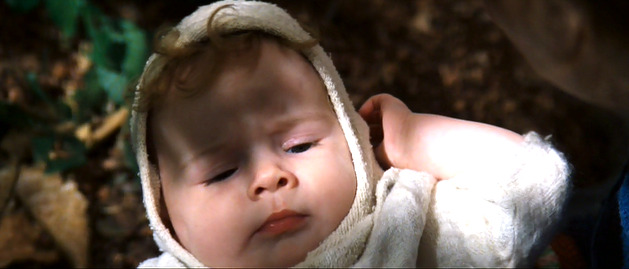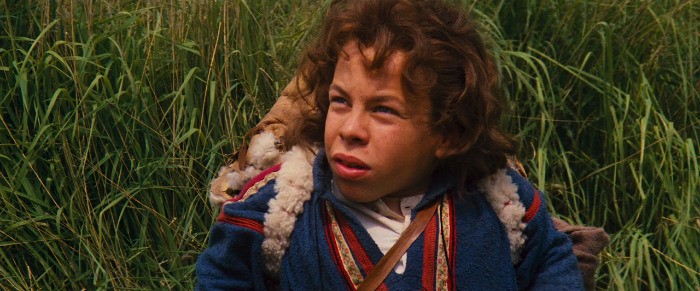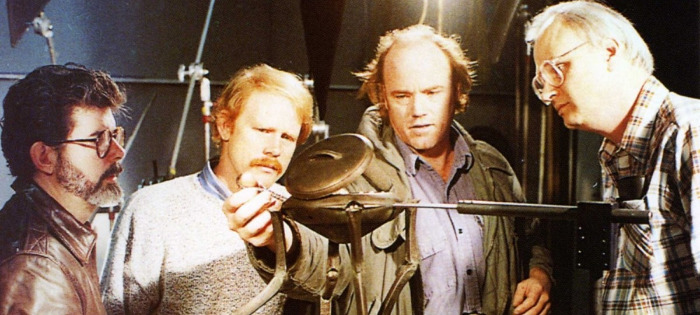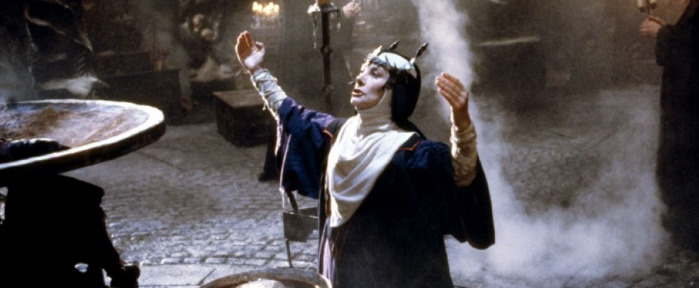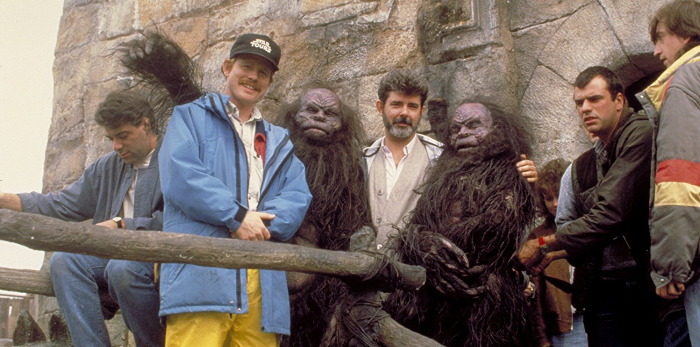30 Years Later, 'Willow' Remains Charming, Empowering, Flawed Fantasy
(Welcome to Nostalgia Bomb, a series where we take a look back on beloved childhood favorites and discern whether or not they're actually any good. In this edition: Willow turns 30 and we take a look back.)
Every summer, my great Aunt Nancy would come to visit my family all the way from Hoboken, New Jersey. She would smell of tub roses, wear long sleeved cardigans in 80 degree weather, and refused to sit in the driver's seat of a car. She seemed out of a children's book novel – as perfectly perfect as any woman could be. Yet somehow around the mid-90s, she became even more grand, after admitting a secret: "Willow is my favorite movie."
And if you were a nerdy kid of such a VHS driven time, this was delightful news to your ears.
With the click of the remote control, Nancy (and a six-year-old me) were transported into this high fantasy world created by George Lucas and director Ron Howard. Lush forests, intimidating mountains, and a rich color palette took over our sight. The cries of an infant, and a powerful musical score, filled our ears – we were fully invested in this cinematic adventure.
With the 30th anniversary of Willow here this week (it was released in theaters on May 20, 1988), I decided it was time to take a trip back to Tir Asleen and see if everything looked the same. What lessons can the film teach moviegoers 30 years later? Does it retain that same flawless childhood magic? And is it too weird to say I still have a crush on Madmartigan?
The Birth of a Child (...or in this case, a movie)
Willow was a product of a time long ago, when swords and sorcery were "the thing" in pop culture. From books to games to TV, the tales of beefy young lads battling the likes of dragons and other mythological creatures seemed to be what was on all our minds...or that's what Hollywood had assumed, anyway. But with the dismal box office returns for films like Krull, Legend, and other fantasy projects, it was becoming clear that Hollywood just wasn't sure how to make and market these movies.
So how did Willow (an idea that George Lucas had conceived in the '70s, originally titled Munchkins) even make it past the drawing board? Well, it was all thanks to Lucas' prior connections. If he hadn't convinced Alan Ladd Jr. of 20th Century Fox to give the green light to Star Wars, Lucas wouldn't have eventually met Warwick Davis on Return of the Jedi (who later would be cast as Willow). Nor would he have gotten Ladd, now working at MGM, to back his new fantasy epic. He also wouldn't have eventually created Industrial Light & Magic, which was where he offered director Ron Howard the Willow gig.
And much like any successful project (or a fantastic game of Tetris), it is all about how the pieces of the puzzle fit together. All of Willow's elements combined into one heck of a final product. But that doesn't always mean they come out without a few pieces missing.
"You're no sorcerer!"
For those that have never seen the film, the story of Willow starts with some exposition text. We learn of a prophecy, in which an evil queen is destined to be defeated by a powerful (soon-to-be-born) girl. To make sure the legend never comes to be, the evil Queen Bavmorda (Jean Marsh) captures all of the pregnant women in the kingdom and plans to kill the baby the moment it is born. But thanks to a clever midwife, the Daikini (human) baby (named Elora Danan) is snuck out of the castle and ends up in the possession of a young magician – Willow Ufgood.
This reluctant hero then must bring the baby back to where she belongs to fulfill her destiny, meeting a rugged swordsman (Val Kilmer), a powerful-but-cursed sorceress (Patricia Hayes), and many other creatures along the way.
As the plot unfolds, it can become quite obvious to Lucas fans how, well, "familiar" certain elements can seem. In fact, if you put the screenplays of Star Wars and Willow side-by-side, you would find a lot of similarities. And we're not talking about the typical Joseph Campbell Hero's Journey type things. Both heroes (Luke and Willow) have farm related careers and are inspired by wizard-like-senior citizens (Obi Wan and High Aldwin/Fin Raziel) to go forth on their quests, and use magical sticks (light sabers and wands) to win their victories. And that's just one character.
But even with such similarities, it is the work of screenwriter Bob Dolman (who spent many months in story conferences with Howard and Lucas at Skywalker Ranch) that allows the story to work overall. His writing transforms Lucas' typical storytelling elements into loving tributes to fairy tale classics – especially through his dialogue ("Magic is the bloodstream of the universe") and character development.
Unfortunately, one of the film's most glaring flaws comes from its length. The film movies briskly at first, right up until Willow and his crew arrive to the cursed kingdom of Tir Asleen. Suddenly, the pace of the story grounds to halt and everything becomes a leaden special effects showcase.
This doesn't ruin the entirety of the story by any means (especially since many consider this battle to be among their favorite scenes in the film) but it ultimately does nothing for the growth of the plot nor the evolution of Willow's cast, except to get Elora captured by the villains (which could have been accomplished many scenes earlier.) Whether you want to blame it on the editing or the script, this is one of the moments where you continuously wish for the heroes to finish up the scene, so they can eventually get to the climax of the tale.
But even with these flawed elements, the true reason for Willow's successes come from the names not at the top of the credits, but from those who stayed (much like the title character) hidden from the Daikini world...or in this case, just off-camera.
The Unsung Heroes
Obviously, a movie like Willow couldn't exist without a decent script, a confident director at the helm, and passionate producer to get it moving. But the real fundamental ingredients of making a truly tasty dish of a movie comes from those secret chefs that add their special spices – and they are one of the reasons why Willow sticks in so many minds 30 years later.
Just minutes into the movie, the lush musical creations of James Horner swell through your speakers and right into your heart. Like in many nostalgic movies of the late '80s and early '90s, it is hard to ignore the importance of Horner's work. His melodies have been the anthems of many cinephiles for decades, and his work on Willow might be among his most underrated – especially considering that there's never been a full release of the score. From the haunting and triumphant tones signaling Queen Bavmorda's evil power, to the tender moments of Willow with his children, James accompanies every moment perfectly, as all good scores should.
Then there are the visuals, that bring Willow's world to life in the grandest of ways. The beautiful backgrounds and the top notch morphing effects prove how much true talent the people from ILM, along with Visual Effects Supervisor Dennis Muren and Matte Painting Supervisor Christopher Evans, had at their fingertips. They were masters of their craft, and showed how much growth they had achieved since Star Wars. And even if some effects were still too ambitious at the time (anything involving the Brownies, really), the effort is still jaw-dropping.
And then there is costume designer Barbara Lane. The best costumes in a film should add to the character's personality and help tell their story. Lane does that by grounding the cast in earthy tones, showing which characters deserve our attention. Willow is clothed in red and an almost heroic royal blue, as if to say he was always destined to save the day, while other costumes transform in refinement and power (like Madmartigan's) as the film progresses.
But there's something else, something much more powerful at the center of Willow that deserves to be mentioned. And it is the reason why I keep coming back to this cinematic quest again and again...
The (Female) Power Within....
It would probably not shock you in the least to learn that I was picked on a lot as a kid. Sometimes it was for my weird vampire-shaped teeth, but usually it was because I was a girl who either was too ugly to hang out with the other girls, or was too weak to play with the opposing team. And at the beginning of this torturous period of my youth, the grand search for any kind of motivational figure had taken over my brain.
The funny thing was that a lot of my personal heroines would come not from the stereotypical pieces of media, but from more unlikely corners – Willow included. For you see, much of Willow's greatest scenes occur between (or revolve around the power of) women and how they can change the future. And as a little girl searching for such images to give her strength (or any sort of inspiration), this made my mind spin in the craziest of ways.
The film gives many beautiful examples of female empowerment. From the confident midwife that sneaks Elora off the castle grounds to Willow's wife, Kiaya, who cuts her hair off to give the hero the luck he needs, there's an obvious theme of women doing anything and everything to help good win the day. There are even women who push their flaws to the side (like Fin Razel being broken from her curse, only to find she has aged significantly from her beautiful young self) to focus on the battle ahead.
But for every wonderful band of courageous chicks working towards a goal, there is always one who shifts more into the love interest category and never grows beyond that. I'm talking about Sorsha. As daughter of Queen Bavmorda and co-leader of her kingdom's army, Sorsha could have become a memorable female character, one with all of the spice and strength of Princess Leia. Yet, once the rebellious Madmartigan lays eyes on this red haired beauty, the script pushes Sorsha into the "girlfriend" category and though it tries its best to recover from said choice (even making Sorsha guide Fin Razel and Willow into her mother's fortress), this character just feels more like a plot device than anything productive or interesting.
Luckily, Sorsha's disappointments don't ruin the work of the other women (both good and bad) at being fantastic examples of female strength on screen. And since the film also passes the Bechdel Test with flying colors, it gives itself a big edge over a lot of the fantasy film competition from its era and beyond. Sure, maybe not all of the female characters are as flawless as I remember them being, but if the majority of them remain as the incredible heroines they were at such a tender age, then Willow can still have that magic effect on all female viewers.
The Legacy
Upon its release in 1988, Willow grossed $57.3 million. Though not the success that Lucas had hoped for, the film (much like other fantasy flicks of the '80s) became profitable on home video. It also was not a home run with critics, including Roger Ebert and Gene Siskel, who considered it one of their worst films of that year. Other critics, like Mike Clark of USA Today, summed up their feelings in a mixed response:
"The film is probably too much for young children and possibly too much of the same for cynics. But any 6–13-year-old who sees this may be bitten by the "movie bug" for life."
And from my personal perspective, that is both Willow's biggest flaw and greatest success – it doesn't have a clear audience. Some elements resemble the darkest and most terrifying elements of true ancient fairy tales, while other moments are straight out of the worst of '80s tropes. Adults upon first viewing (much like my boyfriend) have a hard to being swept by the magic on screen, while many children will find themselves too scared to venture forth with Willow on his quest. But when you show this film to the right person at the right age, their eyes can open to show all of film's possibilities, and inspire their creative juices, much like yours truly.
But no matter what criticism is thrown its way, Willow will always remain one of my favorite creations of the '80s, simply because of the film's humble nature. Right from the start, Willow knows that it isn't as glamorous as Labyrinth, or aesthetically beautiful as Legend, nor does it have the ridiculous over-the-top action of Highlander or Conan the Barbarian, but it doesn't care. Because much like our lead hero, Willow (as a film) is proud of what it is and that pride can be felt in every frame.
It proves that genre films should take risks, because even if not every single one of them pays off, audiences will remember your film more for their successes than failures. It also shows that you can have female characters be an integral part of the plot, without kids questioning the believability of their strengths. And most importantly, it shows that a hero can be anyone, of any stature, and bring some of their own individuality to the quest to help everyone achieve their goals. And those are lessons that we need to be reminded of. And often.

